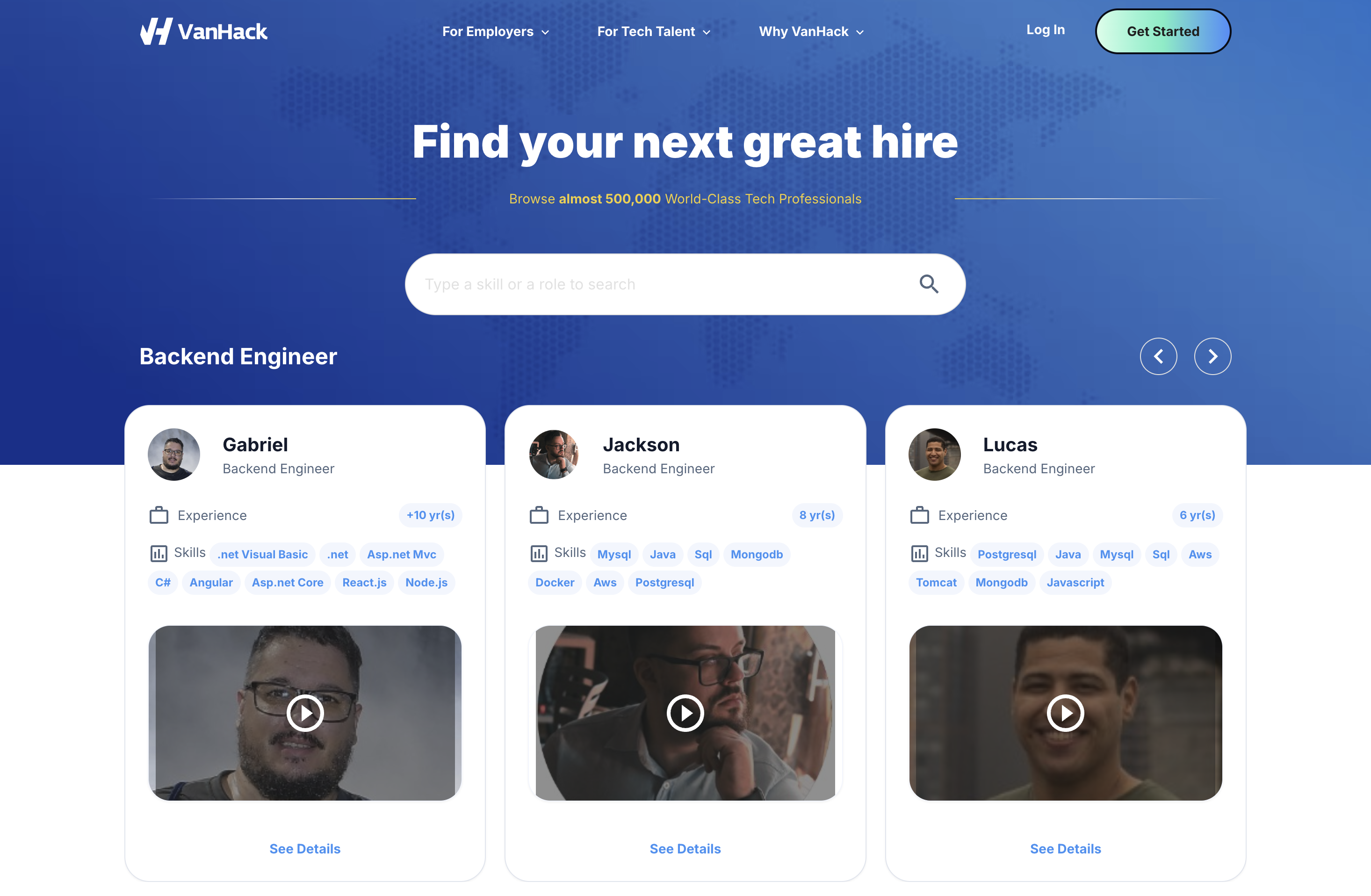Building a strong engineering team is a game-changer for startups aiming to grow fast, stay competitive, and deliver top-notch products. Relying on generic job boards to find talent just doesn’t cut it anymore. Startups need a focused strategy that taps into global talent pools, aligns with business goals, and bridges cultural gaps. This guide walks you through hiring remote LATAM developers, helping you avoid common missteps and build a team that drives results. Ready to get started? Begin hiring with VanHack now to access skilled remote LATAM talent.
Why Strategic Team Planning Matters for Growth
Understanding Key Hiring Concepts
Start by distinguishing between talent acquisition and recruiting. Talent acquisition is a long-term, strategic process that syncs hiring with your business vision. Recruiting, on the other hand, is about filling open roles quickly. For startups, talent acquisition means planning ahead for technical needs, creating a pipeline of candidates, and scaling without losing quality.
Defining seniority levels is also critical when hiring remotely. Senior engineers, with 5 to 8 years of experience, often lead technically while coding. Staff engineers, with 8 to 12 years, handle system design and coordination. Principal engineers, with over 12 years, shape technical direction. Each level needs tailored compensation and onboarding, especially in LATAM markets.
Compensation for remote LATAM talent requires a smart balance. While equity can attract senior developers, cash payments in USD are often the deciding factor. Offering USD-based salaries helps ensure stability and competitiveness in fluctuating markets.
Essential Frameworks for Remote Hiring
Assessing technical skills in remote teams means adapting to async communication and varied backgrounds. Use a mix of coding challenges and practical scenarios that mirror real work. Evaluate not only coding ability but also how candidates communicate, solve problems, and adapt to your team’s culture.
Cultural fit gets trickier with remote teams across time zones. Focus on shared values like teamwork and growth over surface-level similarities. Check candidates’ remote work experience, communication habits, and ability to stay connected while working independently.
Startup hiring often juggles speed and quality with limited resources. Unlike big firms, startups can’t rely on large recruiting teams. Create streamlined processes with clear criteria to make quick, effective decisions without cutting corners.
Aligning Talent with Business Goals
Your engineering hires should directly support product plans and milestones. Identify the skills needed for upcoming launches or debt reduction. Map roles to specific goals so new team members contribute right away.
Hiring strategy ties into fundraising, too. Investors look at your team’s strength to gauge execution potential. A well-planned engineering team shows depth and scalability, boosting confidence during funding rounds.
Strong teams also speed up product iterations and improve quality, giving you a market edge. Your ability to respond to feedback and build better products hinges on the talent you bring onboard.
Should You Build or Outsource Hiring Capabilities?
Deciding between an internal hiring team or an external partner depends on your current setup and goals. Internal teams offer control but demand heavy investment in time and money. External partners provide instant access to expertise and networks, though they need careful selection. Weigh factors like hiring volume and technical needs. Explore VanHack’s expertise in sourcing remote LATAM developers to simplify the process.
Exploring the LATAM Developer Talent Market
What Defines the Global Talent Landscape?
The engineering talent market splits into segments with unique dynamics. Big tech firms often snag top talent with high pay and prestige. Startups, however, attract developers with equity, growth potential, and exciting challenges that fast-track careers.
Latin America stands out as a key hub for developers, thanks to solid technical education, alignment with North American work styles, and convenient time zones. Nations like Mexico, Brazil, Colombia, and Argentina have thriving tech scenes, producing talent skilled in current tools and methods.
How to Source Remote Talent Effectively
Different approaches exist for finding remote developers. Here’s a quick breakdown:
- Executive search firms target senior roles, charging 25 to 35% of first-year pay. They’re great for leadership hires but costly for most startup needs.
- Specialized firms like VanHack focus on niche talent, offering pre-vetted candidates and support for remote integration, adding value beyond basic sourcing.
- Talent platforms use AI for matching, but often shift screening work to you, requiring extra effort.
- Internal teams align closely with your goals but demand significant resources, often impractical for startups under 100 employees.
How Remote Work and AI Shape Hiring
Remote work has opened up global talent pools, letting companies hire based on skill, not location. This also allows pay to reflect local rates, not just headquarters costs.
AI tools streamline sourcing and initial assessments with better matching. Still, human judgment remains key for evaluating fit and complex skills.
Salaries are rising across markets, though LATAM remains more affordable than North America. Developer pay in the region is climbing steadily, yet offers clear cost benefits.
Why Traditional Hiring Falls Short for Startups
Generic job boards flood you with applications, but finding qualified candidates takes heavy filtering. Senior developers rarely use these channels anyway, as they’re already in demand.
Referral programs shine for big companies with wide networks, but startups often lack the scale to benefit. Small teams mean fewer connections to tap.
General recruiters may not grasp technical needs or specific tools, leading to poor matches and frustration on both sides.
What’s New in Remote Team Planning?
Accessing global talent gives startups an edge if they manage remote setups well. Benefits include faster hires, lower costs, and skills not found locally.
Engaging with tech communities through open source or events builds your brand. Developers seek out companies with a strong technical presence rather than generic job ads.
Standing out as an employer means highlighting unique challenges, autonomy, and impact. Remote-first firms often attract talent by prioritizing flexibility over standard perks.
Critical Factors in Hiring Remote LATAM Developers
Internal Teams or External Partners: What Fits Best?
Building an in-house hiring setup costs a lot, with senior recruiters earning $120,000 to $180,000 yearly, plus tools and overhead. This only pays off if you’re hiring 20 to 30 engineers annually.
Partnering with specialists like VanHack gives instant access to pre-vetted talent and integration support, skipping the upfront costs.
A hybrid model works for mid-sized startups, blending internal decision-making with external sourcing. It balances control and expertise effectively.
Breaking Down Costs and Resources
A full-time recruiter’s cost, including benefits and tools, hits $150,000 to $200,000 yearly, filling 15 to 25 roles based on complexity. That’s a big commitment.
Specialized search fees range from 15 to 25% of salary for mid-level hires, and up to 35% for seniors. This offers predictable costs and often better quality for smaller hiring needs.
Delayed hires hurt more than direct costs. A vacant senior role can cost $15,000 to $30,000 monthly in lost progress and team strain.
Managing Change for Global Expansion
Adding remote hires means rethinking communication and tools. Set clear protocols, align work hours where possible, and create onboarding that ties remote staff to your mission.
Culture-building with distributed teams needs explicit effort. Define values, document processes, and adapt meetings to include everyone, benefiting the whole company.
Existing teams must adjust, too. Train them on remote collaboration and pair new hires with buddies to ease integration and build connections.
Tracking Success in Remote Hiring
Measure how fast new hires contribute. Aim for 50% productivity in 30 days and full impact by 60 to 90 days. Longer delays suggest onboarding issues.
Retention should hit 90% at 12 months and 75% at 24 months for remote staff, matching local rates. Lower numbers point to fit or pay problems.
Look at product velocity as the true payoff. New hires should boost feature delivery and quality within 6 to 12 months.
Quality hires perform well, blend into the team, and show growth potential, justifying continued investment.
VanHack: Simplifying Remote LATAM Talent Hiring
How Top Startups Build Remote Teams
Smart startups view remote LATAM hiring as a strategic move. They focus on solid onboarding, clear communication, and growth paths that draw in skilled developers.
Setting the Bar for Specialized Recruiting
Effective recruiting partnerships prioritize speed and quality. The goal is to cut hiring time while ensuring candidates match both skill and cultural needs.
How VanHack Vets and Connects Talent
VanHack’s AI tool, Vanna, uses advanced matching to link job needs with candidate skills, delivering shortlists of 3 to 5 top fits. This saves hiring managers time.
The vetting includes video intros for communication checks, AI-driven technical interviews with scores, and coding tests with clear benchmarks, providing deep candidate insights.
With a direct hire model, companies employ talent outright, avoiding ongoing fees and maintaining full control over their teams.
Tap Into VanHack’s Extensive Talent Network
VanHack’s pool of over 500,000 professionals features pre-vetted senior developers with verified skills and clear expectations. Detailed data beyond resumes speeds up evaluations.
Specialization in LATAM markets means VanHack understands local pay standards and cultural nuances, aiding better matches and smoother onboarding.
Supporting Your Startup’s Scaling Goals
VanHack aligns with startup growth through flexible models and quick sourcing. Tools like Slack channels, dashboards, and scheduling APIs fit into your existing workflows.
Global mobility support handles relocation details, from visas to housing, easing the load on companies and helping employees settle in.
Post-hire, local VanHacker networks connect relocated staff, building community support. Hire efficiently with VanHack to access these services for your team.

VanHack Compared to Traditional Hiring Methods
|
Feature |
VanHack |
In-House Recruitment |
Generic Job Boards |
|
Candidate Vetting |
In-depth, AI-driven, shortlisted talent |
Depends on team, often thorough |
Very little |
|
Cost Model |
Flat subscription or per-hire fee |
High, ongoing salary and benefits |
Per-post or subscription fees |
|
Time-to-Hire |
Quick, 3-5 candidates in days |
Slower due to sourcing |
Slowest, high application volume |
|
Global Mobility Support |
Full in-house relocation help |
Needs extra resources or partners |
Not offered |
Is Your Startup Ready for Remote LATAM Hiring?
Assessing Your Global Hiring Readiness
Check if your startup can handle remote LATAM hires by reviewing communication, tools, and management skills. Firms with solid remote policies and documentation tend to integrate hires better.
Strong processes, like standard onboarding and clear performance tracking, are key. If these aren’t in place, build them before scaling remote efforts.
Ensure hiring aligns with business goals and product plans. Misaligned hires can disrupt culture and reduce impact, even if they’re skilled.
Finding Key Players for Hiring Success
Map out decision-makers, from tech leads to execs, who shape hiring. Buy-in across levels is vital for integrating remote teams.
Identify team members to oversee remote onboarding and ongoing management. They need strong communication and distributed team experience.
Choose change champions, influential staff who can support remote integration and tackle resistance or process hurdles.
Prioritizing Engineering Roles for Impact
Rank roles by their effect on product growth, debt reduction, and skill-building. Focus first on high-impact positions for quick returns.
Assess urgency for roles critical to timelines or commitments. Urgent needs might justify faster sourcing or higher costs.
Evaluate long-term value of roles for competitive edge and team growth. Strategic hires, even senior ones, can be worth the investment.
Weighing Internal vs. External Hiring Needs
Compare your hiring volume and skills needs against current resources. Big gaps suggest partnering externally is smarter than building in-house.
Look at costs and focus required for internal hiring versus outsourcing. Factor in both direct expenses and leadership time.
Consider risks like quality issues or delays with each approach. External partners often reduce risk with proven methods and guarantees.
Planning Timelines for Global Hiring
Sync hiring with product launches and tech upgrades. Plan team growth to stay ahead of development needs, not just react to them.
Coordinate with fundraising cycles, as investor reviews often hinge on team strength. Growth during these periods can boost outcomes.
Factor in market trends and customer demand when timing hires. Strategic additions can help seize opportunities or counter competition.
Common Mistakes to Avoid in Remote LATAM Hiring
Cultural differences can trip up remote LATAM hiring. Even with strong English and familiarity with North American norms, variances in communication or work styles matter. Invest in cultural onboarding and stay attuned to preferences.
Using outdated or generic salary data leads to uncompetitive offers. Senior LATAM developers average $54,000 yearly, far above junior pay at $25,800, but numbers differ by country and skill. Use fresh, specific data to stay attractive.
Legal oversights, like tax or IP issues, pose risks in international hiring. Many startups miss the complexity of global employment rules, needing proper frameworks.
Technical assessments often fail if designed for local hires. Adapt them for remote contexts, balancing rigor with fairness across environments.
Assuming uniform pay across LATAM markets creates salary mismatches. Senior developer pay ranges from $52,500 yearly in Costa Rica to $21,300 in Argentina. Tailor offers by location.
Underestimating premiums for in-demand skills leads to low offers. Pay varies widely by tech stack and region, so budget accordingly for specific roles.
Offering local currency instead of USD lowers competitiveness and adds exchange risks. USD-based pay attracts and retains top talent, especially in unstable economies.
Answers to Common Questions on Remote LATAM Hiring
What Cost Savings Come from Hiring LATAM Developers?
Hiring senior LATAM developers often cuts costs compared to US rates. Salaries are generally lower, though they vary by country. Factor in savings from quicker hires and operational efficiencies alongside direct pay differences.
What Drives Salary Gaps Among LATAM Developers?
Seniority is the biggest factor, with experienced developers earning more. Location creates wide differences, as does expertise in high-demand tech. Remote developers for US firms often earn above local averages, increasing competition.
How Do Remote-Friendly Firms Stand Out for Talent?
Companies offering flexibility, growth, and clear advancement paths draw top LATAM talent. Highlighting professional development and international exposure boosts acceptance rates and retention over local-only offers.
How Does VanHack Ease Global Hiring Challenges?
VanHack offers full mobility services, managing visas, housing, and family relocation. This cuts administrative and legal hassles for startups. Local networks also support relocated staff, helping them build connections.
What’s the Timeline for Hiring with VanHack?
VanHack moves fast, starting with an onboarding call to set role needs via Slack. Their AI scans a 500,000+ candidate pool, delivering 3 to 5 vetted matches. Review detailed profiles, including videos and test scores, before final interviews.
Build Stronger Teams with Remote LATAM Talent
Hiring remote LATAM developers is a powerful way for startups to gain skilled talent and flexibility. Mastering global hiring, cultural fit, and remote management sets you up for success.
This guide lays out practical steps to create high-performing distributed teams that speed up product delivery and growth. Moving past outdated hiring methods is key, as is partnering with experts for integration.
VanHack combines AI matching, thorough vetting, and relocation support to simplify LATAM hiring. This lets startups focus on building great teams.
Planning and the right partnerships are essential to unlocking global talent. Invest in solid strategies to fuel your growth.
Looking to strengthen your engineering team? Start with VanHack today and connect with top remote LATAM developers to power your startup’s future.



